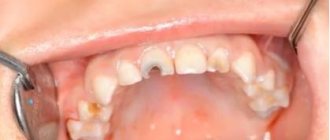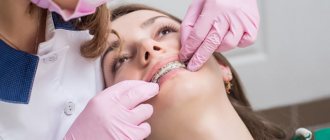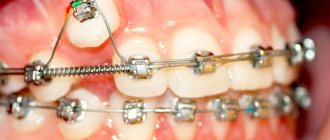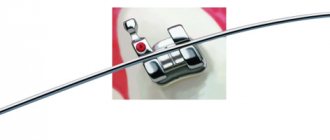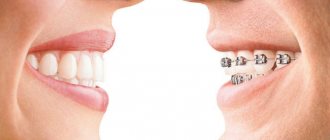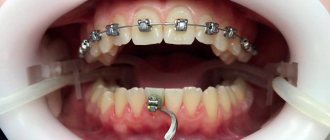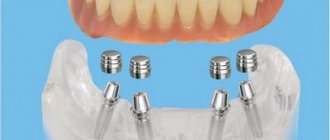Crooked teeth and malocclusion negatively affect not only the health of the teeth and surrounding tissues, but also the child’s self-esteem, self-confidence, and relationships with peers. Therefore, parents turn to an orthodontist with the question: at what age can a child get braces? We will answer in this article.
In this article
- What is malocclusion and why does it occur?
- Why do children get braces?
- Why is it important to correct an abnormal bite?
- At what age do children get braces?
- How are malocclusions treated at an earlier age?
- Until what age are braces placed on adults?
- Types of braces
- Conclusion
What is malocclusion and why does it occur?
A person has two jaws - upper and lower. The closure of the teeth of the two jaws is called a bite. If this closure is even, the bite is considered correct; if the teeth of one row, when closing, overlap the teeth of the second row, they speak of an incorrect bite. Orthodontists treat such dental disorders. Malocclusion often develops in childhood and can be due to various reasons.
- Difficult pregnancy and childbirth.
One of the common causes is birth trauma, which results in pathologies of the neurological system and musculoskeletal system. These disorders lead to improper development of the jaws.
- Mistakes when breastfeeding.
In a baby, the upper jaw is larger than the lower jaw. When a baby nurses, the jaw muscles naturally tighten and alignment occurs. If the baby is not breastfed or eats incorrectly, the formation of a correct bite may be disrupted.
- Poor posture, problems with the musculoskeletal system.
If a child often slouches, not only the spine is deformed, but also the position of the jaw.
- Lack of teeth.
If for some reason a tooth falls out or is removed ahead of schedule, other teeth tend to take up the vacant space, the habit of gnawing hard objects appears, and the tone of the masticatory muscles is impaired.
Also, the cause of malocclusion may be a short frenulum of the tongue, a lack of vitamins and minerals in the diet. The bite is formed incorrectly in those children who often suffer from acute respiratory viral infections and in whom normal nasal breathing is disrupted. They are forced to keep their mouth slightly open, which leads to abnormal bite development.
Why do children get braces?
One of the most popular and effective ways to correct a bite is to install braces. What it is?
A brace system is an orthodontic structure that consists of a metal arch and small plates that are attached to each tooth. The operating principle of braces is based on shape memory. When braces are attached to crooked teeth, they attempt to return to their original position. As a result, it puts pressure on the teeth and moves them in the right direction. It is the doctor’s task to calculate the position of each bracket on the tooth so that they are aligned when displaced.
Children are usually given braces for several years. The design is non-removable, so it is very important to carefully take care of dental and oral hygiene when wearing braces. Bracket systems may differ in materials, structure and other characteristics. By location, they are external (located on the outside of the teeth) and internal. External braces usually cost less and are easy to install. Modern models are made from transparent materials, so they are almost invisible on the teeth.
Lingual, or internal systems, are attached to the inside of the teeth. They are not visible from the outside, so these braces are suitable for a teenager who is embarrassed to wear any structures on his teeth. It is important for parents to know that internal braces are more expensive than external braces. In some cases, minor problems with diction may appear, which usually go away quickly as you get used to it.
What you need to know before installation
You can install braces only if all your teeth are completely healthy. In addition, it is important that the patient is able to follow all the rules for caring for the oral cavity while wearing it. Therefore, before contacting an orthodontist, it is necessary to undergo an examination by a dental therapist.
There are several other important points that you need to prepare for before installing braces:
- the need to change the menu, you will have to give up hard foods, sour and sticky foods;
- It’s worth acquiring special tools for cleaning your teeth and the system itself;
- It is necessary to take into account that during the first few days you will have to get used to the new device in your mouth, so minor difficulties in speech may be observed.
In our dentistry, you can install braces from the most experienced specialists who have extensive practice with curvatures of varying levels of complexity and even pulpless teeth. We use innovative methods, and it is possible to choose a system from a huge variety of options.
Why is it important to correct an abnormal bite?
Some parents do not want to put braces on their children, even if the teeth are severely crooked and do not fit together correctly. They believe that crooked teeth do not affect the child’s health, which means they should not interfere with the natural processes of the body.
Dentists do not share this position. They are convinced that malocclusion needs to be corrected because it leads to a number of problems:
- The child’s speech formation may be disrupted and it becomes incomprehensible.
- Crooked teeth interfere with normal chewing of food, which can lead to gastrointestinal diseases.
- Giving a teenager braces is also important from a psychological point of view. Crooked teeth develop complexes in him, attract negative attention from others, which affects the self-esteem of a boy or girl.
It doesn’t matter at what age you noticed a malocclusion in your child. You should immediately make an appointment with an orthodontist. Even if it is too early to put braces on a child, a specialist may recommend wearing an orthodontic plate or other methods of bite correction. In addition, regular observation by an orthodontist is important at any stage.
Rules for caring for braces
Strict adherence to specialist recommendations regarding oral hygiene will prevent the rapid development of caries and maintain dental health. A toothbrush is not enough to maintain perfect cleanliness; it is recommended to use brushes and special foam after each meal, regardless of location. Teenagers should give up crackers, chips, and any solid food. Braces are the most popular way to correct uneven teeth; most teenagers themselves initiate visits to the orthodontist and strive for perfection.
Positive reviews from patients of various age categories indicate the effectiveness and safety of braces. Teenagers do not experience problems with eating and give up bad habits: snacking on the go, eating chips and crackers, which negatively affect all organs without exception. Braces radically change the way of life; the reflection in the mirror inspires teenagers to follow the rules of hygiene and the recommendations of the orthodontist.
Straight teeth are less vulnerable to negative influences, it is easier to clean, and food does not remain in hard-to-reach places. The result gives aesthetic pleasure; impeccable appearance has a positive effect on the self-esteem of the developing personality. The safety of the materials from which modern braces are made has been confirmed by laboratory tests. Even if the brace comes off the tooth and the child accidentally swallows it, negative consequences are excluded.
The cost of braces, compared to the result and the health of the child, is negligible. Regular visits to the orthodontist will help the young patient get rid of the fear of the dentist; careful hygiene will become a habit.
At what age do children get braces?
Dentists do not have a common view on this issue. Some orthodontists are confident that from the age of 7-8 years it is already possible to begin bite correction with a brace system. The main thing is that by this age the child’s second molars have fully erupted, the teeth are of sufficient length to attach the bracket, and the enamel has good strength. Other orthodontists categorically do not install dental braces before the age of 13.
So when should you put braces on your child? Most experts agree that it is closer to adolescence. It is important to take into account the individual characteristics of a particular patient, the number of crooked teeth, the degree of malocclusion, the strength of the enamel and many other factors. When a child gets braces too early, there is a risk of damage to tooth enamel, root resorption, and even loss of permanent teeth. Therefore, when asked at what age it is better to install braces, most doctors answer - at 13-14 years old. After installation, you can wear braces until you are 18 years old. This age period is considered the most optimal for bite correction. On the one hand, teeth are pliable and easy to straighten. On the other hand, tooth enamel is strong enough to withstand the heavy load of the orthodontic apparatus.
Benefits of implantation
Implantation is the procedure of installing a titanium pin, which simulates a root, into the jaw bone. A crown is then placed on this pin. The implant completely replaces the natural tooth, which is the main advantage of this dental procedure.
The main advantages of implantation:
- If the implant is made and installed with high quality, its service life is at least 15 years (but most often it remains with the patient forever).
- Unlike other types of prosthetics, implantation does not damage adjacent teeth.
- Aesthetic attractiveness of the dentition, a beautiful smile.
- Possibility to install any number of implants.
- Titanium pins take root in 90%; after adaptation there is no discomfort.
- When chewing food, the load is distributed evenly.
- A wide selection of designs and implantation methods provides an individual approach.
The success of the implantation procedure directly depends on the professionalism of the doctor. Choosing a good clinic with experienced dentists, quality materials and following all hygiene rules will give you a beautiful smile and comfort.
How are malocclusions treated at an earlier age?
If the child has not yet reached adolescence and the doctor does not recommend braces, orthodontic treatment is carried out in other ways.
For example, at 6-10 years of age, children may be prescribed the wearing of removable plates, elastic mouthguards, as well as therapeutic and preventive measures that have a positive effect on the bite. At this time, if necessary, surgical plastic surgery of the frenulum of the tongue is performed, the child is prescribed a set of exercises that normalize the muscles of the cheeks, tongue, and lips. To correct the direction of teeth growth during teething, the orthodontist may recommend a special massage.
When such manipulations are carried out correctly in the oral cavity, optimal conditions are created for proper tooth growth and natural bite correction. In most cases, such procedures serve as a preparatory stage for continued treatment during adolescence, when braces are installed. Early orthodontic treatment can reduce the time spent wearing braces and the amount of medical intervention.
Moral preparation of the child
Any medical intervention is stressful for a developing personality; a preliminary conversation with a qualified specialist is a mandatory stage; it is necessary to establish contact. Some teenagers react painfully to any changes in appearance; in such situations, preference should be given to sapphire or ceramic systems. Most teenagers do not have complexes; after discussing the effectiveness of treatment with peers, studying information on the Internet, and communicating with their doctor, patients agree to a budget option - metal braces.
Until what age are braces placed on adults?
If bite correction was not carried out before adulthood, it will be more difficult to correct the violations later. But modern dental technologies make it possible to correct the bite even in adulthood.
The specificity of wearing braces in adults is that the dentition is not so pliable, and it takes more time to change the position of the teeth. Additionally, for adults, braces can be uncomfortable and may require the removal of one or more teeth.
Understanding the difficulties of correcting bites in adults, many parents try to correct the problem in childhood.
Types of braces
Modern dentistry offers a huge selection of braces made from different materials:
- Metal ones are suitable for everyone, including teenagers. They are distinguished by their affordable price, durability, and strength. They effectively cope with bite correction, but their aesthetic characteristics leave much to be desired. Therefore, many teenagers do not want to wear metal braces.
- Sapphire ones look more aesthetically pleasing on the teeth and are not as noticeable as metal ones. But they are expensive and cannot cope with all malocclusions.
- Plastic braces have good aesthetic properties, are hardly noticeable on the teeth, but are inferior in strength to metal ones. If the braces break, they will have to be replaced, which delays the orthodontic treatment. Plastic structures may change color due to coloring food and drinks.
- Lingual braces are also suitable for patients of all ages, including children. But for installation you need a sufficient length of teeth. Internal braces are expensive and are not suitable for correcting complex malocclusions. The main advantage is that they are not so noticeable on the teeth.
- Ceramic. Children are rarely given such braces; they are mainly used to correct the bite of adult patients.
Timing of correction
For teenagers and young people under 25 years of age, correction will take a year and a half. While an adult will have to wear braces to correct his bite and teeth twice as long, sometimes up to 5 years.
The duration of wearing products after 30 is longer for the following reasons:
- Slow metabolism.
- Stopping the growth of the dental-jaw system.
- Tissue regeneration is slow.
Because of this, adults have to change their dentition (sometimes with removal), and shift incorrectly positioned teeth using an orthodontic device.
A wide selection of braces designs allows each patient to choose the optimal solution for treating disorders.
At any age, the application of correction will be successful and highly effective, the only difference being how long it will take.
From the video you will learn about braces for adults.
